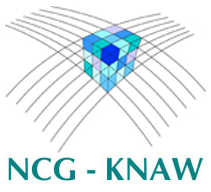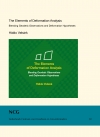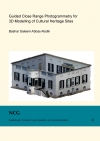
Tobias Wittwer
Publications on Geodesy 72
Delft, 2009. 213 pagina's. ISBN: 978 90 6132 315 0.
Summary
Terrestrial gravimetry, airborne gravimetry, and the recent dedicated satellite gravity missions Challenging Minisatellite Payload (CHAMP), Gravity Recovery and Climate Experiment (GRACE), and Gravity and Ocean Circulation Explorer (GOCE) provide us with high-quality, high-resolution gravity data, which are used in many application areas such as
- the computation of global static gravity fields, in support of precise orbit determination of many Earth observation satellites;
- the quantification and interpretation of mass transport in the Earth system such as the shrinking of ice sheets, the shifting of ocean currents, and water storage variations;
- the computation of high resolution regional and local gravity fields in support of height system realisation and the modelling of reservoirs and geophysical features.
Traditionally, for each data set (satellite, airborne, terrestrial) dedicated data processing schemes have been developed using different estimation principles, parametrisations, etc. The optimal combination of different data sets would benefit of a methodology that can be used for any type of data. Elements of this methodology comprise a uniform parametrisation, estimation principle, data weighting scheme, regularisation, and error propagation.
In the framework of this thesis, such a methodology is developed. It uses radial basis functions (RBFs) as parametrisation. They have parameters that allow us to tune their approximation properties as function of the data coverage and distribution and the signal variations. This makes them equally well suited for global and local parametrisation. Moreover, there exists an analytical relationship between a spherical harmonic representation and a radial basis function representation, which allows the latter to be transformed into the former, without any approximation error. Among others, this has the advantage that one can make use of existing processing tools, such as spectral analysis.
Although radial basis functions are not new in gravity field modelling, there are many important issues which have not yet been addressed or require further research. The main research question underlying this thesis is: "Are radial basis functions a suitable parametrisation for global and regional models of the mean and time-variable gravity field, and if so, how do they perform compared with spherical harmonic solutions?" Directly related to this is the question: "Are there situations where radial basis functions models outperform spherical harmonic solutions?" The answer to both questions is positive as will be shown in this thesis.
There are two important aspects that determine the quality of a gravity field model based on radial basis functions: 1) the spatial distribution of the radial basis functions, i.e. the basis function network design, and 2) the choice of the bandwidths of the radial basis functions. For both problems, semi-automatic algorithms have been developed. Data-adaptive network design and local refinement avoid respectively over- and underparametrisation by fine-tuning the basis function network based on the data. The basis function bandwidth is determined by optimising the fit to the data including control data.
The computation of regional gravity fields constitutes a considerable numerical workload, especially since the methodology presented here does not use an iterative normal equation solver (e.g., the preconditioned conjugate gradient method). Instead, a Cholesky solver is used, which requires the assembly of the complete normal equation system. For this purpose the program is numerically optimised and fully parallelised for hybrid high performance computer architectures. This guarantees optimal performance on all types of parallel computers and handles the memory requirements.
The modelling of satellite data with radial basis functions is investigated using real data of the GRACE satellites collected over the period 2003-2006. An optimal Wiener filter has been developed for radial basis functions in line with the optimal Wiener filter approach previously developed at DEOS for spherical harmonic representations. Monthly GRACE gravity models computed using radial basis function are compared to spherical harmonic models, and validated using independent data provided by the Ice Cloud and Land Elevation Satellite (ICESat), radar altimetry satellites, and the global hydrological model PCR-GLOBWB. Two applications were considered: 1) mass variations over Greenland and Antarctica and 2) water storage variations in river basins. The results show that the radial basis function approach yields solutions that are of at least the same quality as global models using spherical harmonics. There is evidence that radial basis functions may provide better spatial resolution and more realistic amplitudes in particular in high-latitude areas. For instance, it will be shown that radial basis function solutions detected signal that could not be seen in spherical harmonic solutions.
Two test areas are used for regional gravity field modelling using real terrestrial data: An area in the northeastern USA and a larger area in eastern Canada. The results show that the data-adaptivity and local refinement algorithms developed in the framework of this thesis provide good solutions of constant quality regardless of the initially chosen grid spacing. The models are compared to the official regional geoid models GEOID03 and CGG05, respectively. In both cases, rms errors of several centimetres remain, which are attributed to different input data and processing strategies.
The combination of satellite and terrestrial data is tested using simulated global and regional data sets. It is shown that a joint inversion of the two data sets yields combined solutions which are significantly better than a solution using the traditional removerestore approach. The addition of satellite data with the corresponding stochastic model compensates the reduced quality of the terrestrial data at long wavelengths.
The examples show that the regional modelling methodology presented here is a very flexible approach that can be applied to all types of gravity data and data distributions, regardless of application, data source, and area size. The quality of the solutions is at least equal to the solutions developed for the stand-alone inversion of individual data sets, while radial basis functions offer numerical benefits. As a result, this approach is already used for marine geoid modelling, and recommended for the modelling of airborne gravity data and data of the GOCE satellite, and for the joint inversion of satellite, airborne and ground-based gravity data.
Contents
- Summary vii
- Samenvatting xi
- Zusammenfassung xv
- Nomenclature xix
- Introduction 1
- Radial basis functions 9
- Mathematical model and estimation principle 37
- Numerical aspects 43
- Gravity field modelling from satellite data 57
- Local gravity field modelling from terrestrial data 129
- Combined modelling of satellite and terrestrial data 155
- Summary, conclusions and recommendations 177
- Bibliography 183
- Curriculum Vitae 191
Samenvatting
Regionale zwaartekrachtmodellering met radiale basisfuncties
Terrestrische gravimetrie, vliegtuiggravimetrie en de recente specifieke satellietzwaartekrachtmissies Challenging Minisatellite Payload (CHAMP), Gravity Recovery and Climate Experiment (GRACE) en Gravity and Ocean Circulation Explorer (GOCE) leveren data van hoge kwaliteit en hoge resolutie, die voor veel toepassingen gebruikt worden, zoals:
- De berekening van mondiale statische zwaartekrachtvelden, ter ondersteuning van de nauwkeurige baanbepaling van vele aardobservatiesatellieten.
- Het kwantificeren en de interpretatie van massatransport in het systeem aarde, zoals het afsmelten van de ijskappen, het verplaatsen van oceaanstromingen en variaties in wateropslag.
- De berekening van regionale en lokale zwaartekrachtvelden met hoge resolutie, ter ondersteuning van de realisatie van hoogtesystemen en de modellering van reservoirs en geofysische kenmerken.
Voor elk data set (satelliet, vliegtuig, terrestrisch) zijn specifieke verwerkingsschema's ontwikkeld die gebruik maken van verschillende schattingsprincipes en parametrisaties etc. De optimale combinatie van verschillende data sets zou profiteren van een methodiek die voor elke data set gebruikt kan worden. Onderdelen van een dergelijke methodiek bevatten een uniforme parametrisatie, schattingsprincipe, methode van data weging en foutvoortplanting. In het kader van dit proefschrift wordt een dergelijke methodiek ontwikkeld. Zij gebruikt radiale basisfuncties (RBFs) als parametrisatie.
Radiale basisfuncties hebben parameters die het mogelijk maken hun approximatieeigenschappen aan te passen als functie van de bedekking en verdeling van de waarnemingen en de signaalvariatie. Dit maakt ze geschikt voor zowel mondiale als ook voor regionale parametrisaties. Verder bestaat een analytische relatie tussen een sferisch harmonische representatie en een representatie in radiale basisfuncties, die het mogelijk maakt de laatste, zonder approximatiefouten, in de eerste te transformeren. Dit heeft onder andere het voordeel dat men gebruik kan maken van bestaande tools, zoals spectraalanalyse.
Ondanks het feit dat radiale basisfuncties niet nieuw zijn in de zwaartekrachtmodellering, zijn er vele belangrijke aspecten die tot nu toe niet behandeld zijn of die dieper onderzocht moeten worden. De hoofdonderzoeksvraag die aan de basis van dit proefschrift staat is: "Zijn radiale basisfuncties een geschikte parametrisatie voor mondiale en regionale modellen van het gemiddelde en tijdvariabele zwaartekrachtveld, en zo ja, hoe presteren zij vergeleken met sferisch harmonische oplossingen?" Direct gerelateerd hieraan is deze vraag: "Zijn er situaties waarin modellen die als parametrisatie radiale basisfunctie gebruiken, beter presteren dan sferisch harmonische oplossingen?" Het antwoord op beide vragen is positief, zoals in dit proefschrift aangetoond zal worden.
Er zijn twee belangrijke aspecten die de kwaliteit van een zwaartekrachtsveldmodel gebaseerd op radiale basisfuncties bepalen: 1) het ontwerp van het netwerk van basisfuncties 2) de keuze van de bandbreedtes van de radiale basisfuncties. Voor beide problemen werden semiautomatische algoritmen ontwikkeld. Een data-adaptief netwerkontwerp en locale verfijning voorkomen respectievelijk over- en onderparametrisatie door het netwerk van basisfuncties aan te passen op de verdeling van de waarnemingen. De bandbreedte van de basisfuncties wordt bepaald door optimalisatie van de data fit inclusief controledata.
De berekening van regionale zwaartekrachtvelden vereist een behoorlijke numerieke werklast Dit wordt versterkt doordat de hier gepresenteerde methode geen gebruikmaakt van een iteratieve normaalvergelijkingsoplosser (bijv. de preconditioned conjugate gradiënt methode). In plaats daarvan wordt een Cholesky oplosser gebruikt, die de opbouw van het gehele systeem van normaalvergelijkingen vereist. Voor dit doel is het programma numeriek geoptimaliseerd en geheel geparallelliseerd voor hybride highperformance computer architecturen. Dit waarborgt optimale prestaties op alle soorten parallelle computers en voldoet aan de geheugeneisen.
Het modelleren van satellietdata met behulp van radiale basisfuncties wordt onderzocht met gebruik van echte data van de GRACE satellieten, verzameld in de periode 2003- 2006. Een optimale Wiener filter werd ontwikkeld voor radiale basisfuncties in overeenstemming met de optimale Wiener filter aanpak eerder ontwikkeld bij DEOS voor sferisch harmonische representaties. Maandelijkse GRACE oplossingen, berekent met radiale basisfuncties, worden vergeleken met sferisch harmonische modellen, en gevalideerd met gebruik van externe data geleverd door de Ice Cloud and Land Elevation Satelliet (ICESat), radaraltimetrie satellieten en een mondiaal hydrologisch model. Twee toepassingen werden beschouwd: 1) massavariaties boven Groenland en Antarctica en 2) wateropslagvariates in rivierbassins. De resultaten tonen aan dat de aanpak met radiale basisfuncties oplossingen levert die van tenminste dezelfde kwaliteit zijn als mondiale modellen berekent met behulp van sferisch harmonischen. Er zijn indicaties dat radiale basisfuncties mogelijk een betere spatiële resolutie en realistischere amplitudes leveren, vooral in gebieden dicht bij de polen. Wij zullen bijv. aantonen dat de oplossingen met radiale basisfuncties een signaal gedetecteerd hebben wat niet zichtbaar is in een sferisch harmonische oplossing.
Twee testgebieden worden gebruikt voor regionale zwaartekrachtmodellering met echte terrestrische data: Een gebied in het noordoosten van de VS en een groter gebied in het oosten van Canada. De resultaten tonen aan dat de algoritmen voor data-adaptief netwerkontwerp en lokale verfijning goede oplossingen leveren, onafhankelijk van de in eerste instantie gekozen gridafstand. De modellen worden vergeleken met de officiële geoïdes GEOID03 en CGG05. In beide gevallen was het kwadratisch gemiddelde van de afwijkingen meerdere centimetres, die aan verschillende data en verwerkingsmethodieken toegekend worden.
De combinatie van satelliet- en terrestrische data wordt getest met gesimuleerde mondiale en regionale data sets. Het wordt aangetoond dat een gecombineerde inversie van de twee data sets oplossingen levert die significant beter zijn dan een oplossing die gebruik maakt van de traditionele remove-restore aanpak. De toevoeging van satellietdata met het bijbehorende stochastische model compenseert de lagere kwaliteit van de terrestrische data in de lange golflengtes.
De voorbeelden laten zien dat de hier gepresenteerde methodiek voor regionale modellering een zeer flexibele aanpak is die voor alle soorten zwaartekrachtdata en dataverdelingen toegepast kan worden, ongeacht de toepassing, databron en gebiedsgrootte. De kwaliteit van de oplossingen is tenminste gelijk aan de oplossingen ontwikkeld voor stand-alone inversies van de individuele data sets, terwijl radiale basisfuncties numerieke voordelen bieden. Als resultaat hiervan wordt deze aanpak al gebruikt voor het modelleren van een marine geoïde, en wordt hij aanbevolen voor het modelleren van vliegtuiggravimetriedata en data van de GOCE satelliet, en voor de gecombineerde inversie van satelliet-, vliegtuig- en terrestrische zwaartekrachtdata.




















